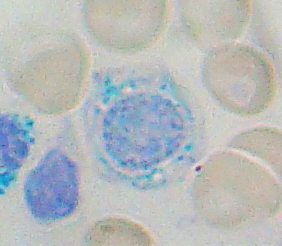X-linked sideroblastic anemia and spinocerebellar ataxia
X-linked sideroblastic anemia and spinocerebellar ataxia (XLSA/A) is a rare genetic disorder characterized by the combination of sideroblastic anemia, a form of anemia caused by the body's inability to incorporate iron into hemoglobin, and spinocerebellar ataxia, a progressive disorder affecting balance and coordination due to degeneration of the cerebellum and its connections. This condition is inherited in an X-linked recessive manner, meaning it is caused by mutations on the X chromosome. As such, it predominantly affects males, though female carriers may exhibit some symptoms due to X-chromosome inactivation.
Causes[edit | edit source]
XLSA/A is caused by mutations in the ALAS2 gene, which encodes the enzyme delta-aminolevulinate synthase 2. This enzyme is crucial for the first step in the synthesis of heme, a component of hemoglobin. Mutations in ALAS2 lead to ineffective heme production, resulting in sideroblastic anemia. The link between mutations in ALAS2 and spinocerebellar ataxia is not fully understood, but it is believed that the accumulation of iron and other metabolic disturbances in the nervous system play a role in the development of neurological symptoms.
Symptoms[edit | edit source]
The primary symptoms of XLSA/A include fatigue and weakness due to anemia, and difficulty with coordination and balance due to ataxia. Other symptoms may include dysphagia (difficulty swallowing), nystagmus (involuntary eye movement), and sensorineural hearing loss. The severity of symptoms can vary widely among affected individuals.
Diagnosis[edit | edit source]
Diagnosis of XLSA/A involves a combination of clinical evaluation, blood tests, and genetic testing. Blood tests typically show a characteristic pattern of sideroblastic anemia, including the presence of ringed sideroblasts in the bone marrow and elevated levels of iron in the blood. Genetic testing can confirm a mutation in the ALAS2 gene.
Treatment[edit | edit source]
There is no cure for XLSA/A, and treatment focuses on managing symptoms. Treatment for sideroblastic anemia may include vitamin B6 (pyridoxine) supplementation, as some affected individuals may respond to high doses of this vitamin. Other treatments may involve iron chelation therapy to manage iron overload and other supportive measures. Management of spinocerebellar ataxia typically involves physical therapy, occupational therapy, and other interventions aimed at improving mobility and function.
Prognosis[edit | edit source]
The prognosis for individuals with XLSA/A varies depending on the severity of symptoms and the response to treatment. While treatment can help manage symptoms and improve quality of life, there is currently no therapy that can halt the progression of the disease.
Translate: - East Asian
中文,
日本,
한국어,
South Asian
हिन्दी,
தமிழ்,
తెలుగు,
Urdu,
ಕನ್ನಡ,
Southeast Asian
Indonesian,
Vietnamese,
Thai,
မြန်မာဘာသာ,
বাংলা
European
español,
Deutsch,
français,
Greek,
português do Brasil,
polski,
română,
русский,
Nederlands,
norsk,
svenska,
suomi,
Italian
Middle Eastern & African
عربى,
Turkish,
Persian,
Hebrew,
Afrikaans,
isiZulu,
Kiswahili,
Other
Bulgarian,
Hungarian,
Czech,
Swedish,
മലയാളം,
मराठी,
ਪੰਜਾਬੀ,
ગુજરાતી,
Portuguese,
Ukrainian
Navigation: Wellness - Encyclopedia - Health topics - Disease Index - Drugs - World Directory - Gray's Anatomy - Keto diet - Recipes
Search WikiMD
Ad.Tired of being Overweight? Try W8MD's physician weight loss program.
Semaglutide (Ozempic / Wegovy and Tirzepatide (Mounjaro / Zepbound) available.
Advertise on WikiMD
WikiMD is not a substitute for professional medical advice. See full disclaimer.
Credits:Most images are courtesy of Wikimedia commons, and templates Wikipedia, licensed under CC BY SA or similar.Contributors: Prab R. Tumpati, MD

